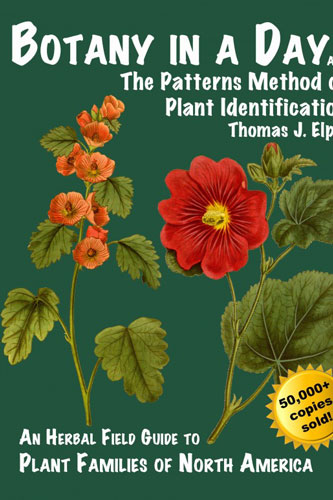Many years ago, Montana resident Thomas J. Elpel dropped off a manuscript entitled Botany in a Day at my office. Over the years many people have submitted manuscript copies of their book to me in the hopes that I would provide some sort of endorsement that could be used for future marketing. Unfortunately, not all were worthy of my endorsement, but this one caught my eye for several reasons.
As the founder and director of the most successful herb course in North America – in terms of numbers of enrolled students and numbers of students who have distinguished themselves professionally in the growing field of herbal medicine, I immediately recognized that Botany in a Day was perfect for herbalists and new students of herbalism.
I contacted Elpel and told him so, and further, that I wanted to make it one of the core textbooks of the East West Herb Course. I think it was 1996-98 or so when this occurred and the first edition of this remarkable book was published. Since that time to the present the book has gone through a total of six editions and has sold over 50,000 copies. Not bad for a self-published and self-distributed book, I’d say. While this is impressive it hardly reflects the true value of such a book to anyone who has an interest in plant identification. The book covers a comprehensive description of plant families of the northern latitudes, especially North America and Canada, but is applicable to most parts of the world above the equator as well as plants on every continent.
It starts out identifying the various parts and patterns of plants with a tutorial on plant names and a section on the evolution of plants that allows one to understand the big picture of plant botany. Following is a segment on “Learning Plants by Families” that teaches the reader to recognize the basic characteristics of the eight most common plant families (Mint, Mustard, Parsley, Pea, Lily, Grass, Rose, and Aster). This covers 45,000 common medicinal herbs and plants one is likely to encounter most frequently. With a basic understanding of these, one is ready to go on to learn the many other families one is likely to encounter.
While not intended as a medicinal herb book, perhaps it is my bias to see it as preeminently a book intended for herbalists, herb students and wild food foragers. As such, it references common biochemical, medicinal and nutritional characteristics.
For most of us, a lengthier and more formal training in botany would promise a long, perhaps dull study with no intended practical application other than learning to identify and classify plants. But Thomas Elpel’s book is a painless approach to the same subject specially tailored to the needs of herbalists and lovers of plants. It approaches the otherwise heady subject of botany on a somewhat limited but totally useful scale with the same sense of satisfaction and fun one might expect from working and solving a crossword puzzle. The end result is a deeper relationship with the plants we know and the possibility of making new plant friends.
Earlier editions of this book were printed in black and white. For the same price, the newly expanded sixth edition has a colorful cover and color depictions of the plants throughout the book.
Click here to purchase the new edition on the Botany in a Day page on Elpel’s website, and don’t forget to check out his other works.

